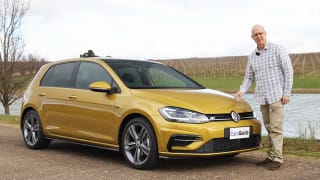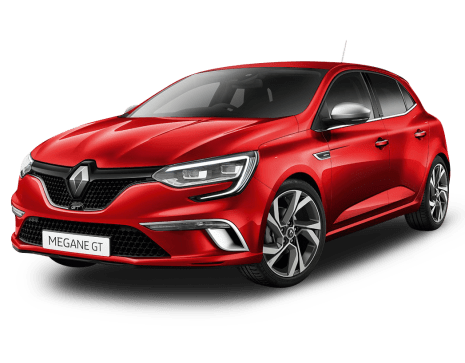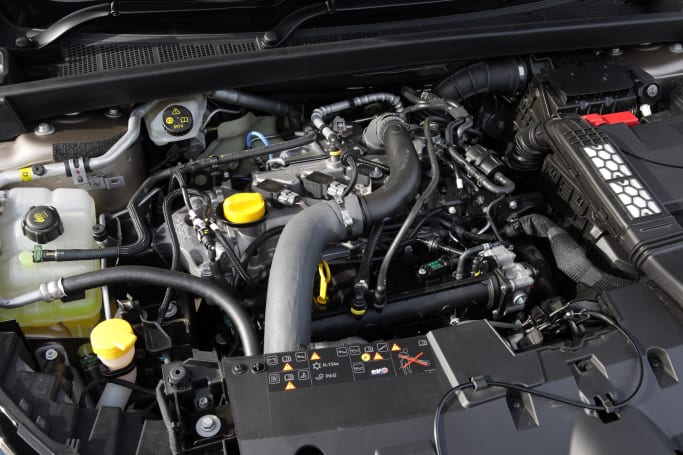
Volkswagen Golf 2017 review
The Golf 7.5, as the name implies, is a substantial mid-life upgrade of the current model. To raise the stakes, and sales (they hope), VW has injected new life into its marquee small-car player.
Browse over 9,000 car reviews
Most car brands pick what they're best at and generally stick to it.
If you think Renault Megane, there's a good chance the downright excellent Renault Sport hot hatch models will spring to mind, with the mainstream but Euro-chic five door hatch following close behind.
You might also think of the Megane convertible, but there's a good chance the sedan and wagon won't have etched a place in your consciousness. Yet.
Part of this is because the last Megane sedan wore Fluence badges, but also because the previous wagon arrived about three years into the third-generation Megane’s life in Australia.

Now they’re back in fourth-generation form, just nine months after the hatch to help broaden Renault’s Australian line-up. But will they change our perception of the Megane model name?
| Renault Megane 2017: ZEN | |
|---|---|
| Safety rating | |
| Engine Type | 1.2L turbo |
| Fuel Type | Premium Unleaded Petrol |
| Fuel Efficiency | 6.1L/100km |
| Seating | 5 seats |
| Price from | $16,940 |
The sedan and wagon’s arrival coincides with Renault’s introduction of ongoing drive-away pricing across the Megane line-up, which is a big plus for buyers trying to identify just how much their new car is going to cost.
Most other brands stick to the less concrete MSRP or list pricing though, so we’ll cover both for each Megane variant to help with cross-shopping. The sedan is available in Zen or Intens trim levels, while the wagon spans Zen, GT-Line and GT badges.
Australians tend to prefer the upper-class Renault variants, so sedan and wagon eschew the hatch’s base Life trim level to kick off with the mid-spec Zen.

The Zen sedan and wagon are identically specified and carry respective list prices of $27,490 and $28,490, with drive-away pricing of $29,990 and $30,490. This puts them just $1000 and $1500 above the hatch (drive-away).
The Zen’ s impressive list of standard features includes a 7.0-inch 'R-LINK 2' multimedia screen with sat nav, a leather-trimmed steering wheel, dual zone climate control, a reversing camera plus front and rear parking sensors, hands-free boot opening, auto wipers and headlights, a full size (but temporary) spare wheel and 16-inch alloys.
The Zen options list extends to the $1990 'Sunroof Pack' which includes an electric sunroof, auto dimming rear view mirror and illuminated sun visor mirror. Also available is the $700 'ADAS (Advanced Driver Assistance System) Pack', which brings city AEB, lane departure warning and auto high beam.
The upper-spec sedan is the only Intens in the Megane range and carries a list price of $31,990 or $35,990 drive-away.

Key additions on top of the Zen’s generally impressive list of standard features include a bigger 8.7-inch 'R-LINK' multimedia screen (with portrait orientation), leather trim, active cruise control, auto high beam, city AEB, blind-spot monitoring, collision alerts, lane departure warning, auto high beam, auto parking function, side parking sensors, a rear seat armrest with cupholders, LED headlights, tinted rear windows, an electric panoramic sunroof and 18-inch alloys.
The sports-flavoured GT-Line is the middle ground of the wagon line-up, and wears a list price of $33,490 or $36,490 drive-away. This represents a $1500 premium over the GT-Line hatch.
GT-Line extra features over the Zen wagon include a Renault Sport body styling pack, an 8.7-inch 'R-LINK 2' multimedia system (with portrait-oriented display), front sport seats with seat heaters, Alcantara seat trim, nappa leather steering wheel, panoramic sunroof, active cruise control, city AEB, collision alerts, blind-spot monitoring, lane departure warning, auto high beam, side parking sensors, auto parking function, a rear seat armrest with cupholders, tinted rear windows and 17-inch alloy wheels.

GT-Line options include the $1490 'Premium Pack' that brings Bose audio and LED headlights, but the Bose subwoofer replaces the spare tyre with an inflation kit. You can also specify 18-inch 'Grand Tour' alloy wheels for an extra $990.
Sitting at the top of the Megane wagon tree is the warmed-over GT, which wears a list price of $39,490 ($42,490 drive-away), or $1500 more than the GT hatch.
Standard features beyond the GT-Line include upgraded brakes, aluminium pedals, black and blue Alcantara seat trim and GT-specific 18-inch alloy wheels.
Optional GT extras include the $1490 'Premium Pack' which brings Bose audio and LED headlights, but the Bose subwoofer replaces the spare tyre with an inflation kit. There’s also the $1990 'Sunroof Pack' which includes an electric sunroof, auto-dimming rear-view mirror and illuminated sun visor mirror.

Apple CarPlay and Android Auto are notable omissions from all variants though, and metallic paint will cost an extra $600 across the board.

Previous Megane sedans, the most recent Fluence and the just-superseded wagon, could all be accused of looking like afterthoughts in a clearly hatch-first design process.
Not this time. Both appear to have been treated to the same level of attention to surfaces, shapes and proportions as the hatch.

The sedan disguises its extra 271mm of rear overhang and 42mm of wheelbase by extending the rear window over the boot area, with muscular rear haunches and sharp creases that keep the eye entertained.
The wagon disguises the 267mm of extra junk in its trunk by continuing its beltline and window line tapers all the way to the D-pillar. The rear window then wraps around the D-pillar, and the result is exciting, not wagon boring.

Both rear ends use unique applications of Renault’s current horizontal-orientation tail-light policy, which makes them instantly recognisable from behind, yet retain distinction between the bodystyles.
Both new bodystyles ride on a longer wheelbase (+42mm in the sedan, +43mm in the wagon), which has helped to liberate an extra 37mm of rear legroom.
This is one area where the hatch isn't too crash hot, but its longer siblings now offer generous legroom for adults to match the already impressive hip and shoulder room.
Also boosting long distance comfort is slightly more rake for the rear seat backrest, and you’ll find ISOFIX child seat mounts in the outboard rear seats of all variants.
All Meganes also have small bottle holders in each door, while Zen models only have two cupholders up the front. Intens, GT-Line and GT versions get the centre rear armrest that houses an extra two cupholders.
The hatch’s 434-litre boot is already pretty big for its class, but the sedan's longer tail gives it an extra 69 litres with the split fold upright to total 503 litres, which expands to 987 litres with the seats folded.
The wagon is even bigger again, with a very useful 580 litres seats-up, or 1504L with the seats folded. These wagon figures trump most mid-size SUVs!
Another impressive element is the full-size temporary spare wheel in all versions (unless a GT-Line or GT fitted with the Premium Pack), which will still limit your speed to 80km/h when fitted, but you don’t have the same distance limitations as with the spindly little tyre on a regular space-saver.
Nothing new here, with the Zen, Intens and GT-Line variants using the same 97kW/205Nm TCe 130 1.2-litre turbocharged petrol four as most hatch variants, paired with a seven-speed dual clutch automatic.

In sedan trim, the claimed 0-100km/h figure is a relaxed 10.9sec, which pushes out to 11.7s with the wagon’s extra weight.
Also like the hatch, the GT scores the significantly more healthy 151kW/280Nm GT 205 1.6-litre turbo four, which knocks 4.3 seconds off the 0-100km/h time to achieve a claimed 7.4sec figure. The seven-speed dual-clutch auto is once again your only transmission choice.
Both sedan variants carry an impressive official combined fuel consumption figure of 6.1L/100km, which steps up to 6.2L/100km for the 1.2-litre equipped wagons, despite adding just 16kg over the sedans.
The GT wagon proves that muscle doesn’t necessarily mean thirst by carrying an even better 6.0L/100km official combined figure, but all Meganes demand Premium 95RON unleaded as a minimum.
The new Megane hatch has garnered near universal praise for its road manners, and despite the extra length of the sedan and wagon these qualities largely remain.
There’s a general air of refinement across the board, from cabin noise, to bump absorption to control weighting, without compromising driver feel.

Cabin presentation is also impressive, particularly in the leather and Alcantara-lined GT-Line and GT. If you can’t quite justify a full-house Renault Sport, you can still feel like you’re part of the team, without the outright performance.
The plastics aren’t quite VW level, but there’s little to criticise aside from Renault’s insistence on locating the cruise control switch well out of sight on the centre console.

The sedan and wagon are only around 70kg heavier than their hatch counterparts, but the little 1.2 in the Zen, Intens and GT-Line is still working harder than ever to move them around. It will keep up with traffic around town, but you wouldn’t call it spritely, and the engine can’t bear all the blame given the transmission’s reluctance to drop gears in the name of improved fuel consumption.
It’s a slightly different story at highway speeds, with the little number riding its torque curve to do a good job of maintaining cruising speed, although it’s not a big fan of overtaking.
The GT wagon is more of a comfortable performer, with the power, but not quite the torque, to elevate it to hot status. One card up its sleeve though is its all-wheel steering system, which effectively reduces the turning circle below 60km/h, and extends it above 60km/h (80km/h in Sport mode).
We didn’t wrangle it into any shopping centre carparks on launch, but you can definitely feel a touch of big car stability with small car nimbleness when throwing it through some corners.
If we were doing the product planning though (and had access to the resources), the GT would make more sense with the 1.8-litre from the new Alpine and the GT-Line with the 1.6. That way each GT derivative would have a performance advantage over the regular models, and the GT would be a closer alternative to the Octavia RS wagon and the Subaru Levorg.
It needn’t get the full circa-200kW of the upcoming RS, but just something closer to the new RS’s 169kW/350Nm.
Basic Warranty
5 years / unlimited km warranty
ANCAP Safety Rating

ANCAP is yet to give any Megane a safety rating, but the sedan and wagon join the hatch in wearing a five star rating from EuroNCAP.
All variants are equipped with front, side and curtain airbags that extend to the back seat, plus the usual suite of stability and traction control functions and front and rear parking sensors and a reversing camera.
As of June, the ADAS (Advanced Driver Assistance System) pack is finally available as standard on all bar the Zen (and Life hatch) variants, which brings city AEB, active cruise control, lane departure warning, collision alerts and auto high beam.
A scaled-back version of the ADAS system is available as a $700 factory-fitted option for lesser variants, but this set-up misses out on the active cruise and collision alerts.
It’s a shame that Renault isn’t able to extend AEB fitment as standard across the board like several of the Megane’s competitors, but it’s still fixed a big safety shortfall.
Like the Megane hatch, the sedan and wagon are covered by Renault’s five-year/unlimited km factory warranty with five years of Roadside Assistance.
Condition-based servicing can extend the service intervals as far as 12 months/30,000km (whichever comes first), and the first three scheduled services are capped at $299 each.
There's no denying the Megane sedan and wagon will be niche players in Australia, given our market’s preference for hatches. But if you’re after a European small sedan with mainstream pricing the Megane sedan is a rare proposition. It looks beaut, and the little 1.2-litre engine punches above its weight. We'd pick the Intens out of the two due to its extra standard kit.
The wagon on the other hand, has competition from the likes of Peugeot, Skoda, Volkswagen, and even Subaru. But while the GT can’t quite match the performance of the hot Skoda and Subaru, the whole wagon range represents yet another very cool alternative to an SUV. From the Megane wagons, we'd pick the GT.
| Vehicle | Specs | Price* | |
|---|---|---|---|
| Life | 1.2L, PULP, 7 SP AUTO | $13,420 – 17,600 | 2017 Renault Megane 2017 Life Pricing and Specs |
| ZEN | 1.2L, PULP, 7 SP AUTO | $13,750 – 18,040 | 2017 Renault Megane 2017 ZEN Pricing and Specs |
| GT-Line | 1.2L, PULP, 7 SP AUTO | $16,610 – 21,340 | 2017 Renault Megane 2017 GT-Line Pricing and Specs |
| GT 205 | 1.6L, PULP, 7 SP AUTO | $23,650 – 29,150 | 2017 Renault Megane 2017 GT 205 Pricing and Specs |
| Price and features | 8 |
|---|---|
| Design | 8 |
| Practicality | 9 |
| Under the bonnet | 6 |
| Efficiency | 8 |
| Driving | 7 |
| Safety | 8 |
| Ownership | 8 |
$15,600
Lowest price, based on 26 car listings in the last 6 months